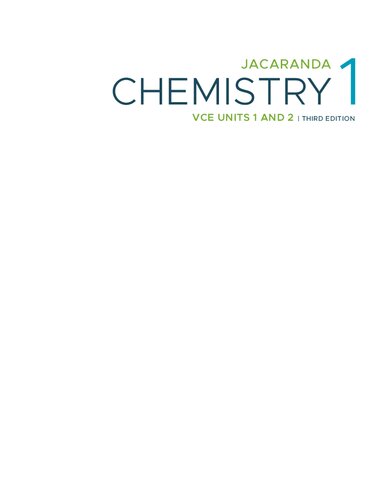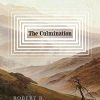Jacaranda Chemistry 1 VCE Units 1 2 3rd Edition by Neale Taylor, Angela Stubbs, Robert Stokes 1119884314 9781119884316
$50.00 Original price was: $50.00.$25.00Current price is: $25.00.
Jacaranda Chemistry 1 VCE Units 1 2 3rd Edition by Neale Taylor, Angela Stubbs, Robert Stokes – Ebook PDF Instant Download/Delivery: 1119884314, 9781119884316
Full download Jacaranda Chemistry 1 VCE Units 1 2 3rd Edition after payment

Product details:
ISBN 10: 1119884314
ISBN 13: 9781119884316
Author: Neale Taylor, Angela Stubbs, Robert Stokes
The best Chemistry series for the new VCE Study Design. Developed by expert Victorian teachers for, VCE students.
Get exam ready: past VCAA exam questions (all since 2013)
Students can start preparing from lesson one, with past VCAA exam questions embedded in every lesson. Practice, customisable SACs available for all Units to build student competence and confidence.
Learn online with Australia’s most powerful learning platform, learnON
Be confident your students can get unstuck and progress, in class or at home. For every question online they receive immediate feedback. Teacher-led videos to learn and re-learn. Instant reports make tracking progress simple.
Combine units flexibly with the Jacaranda Supercourse
An Australian first, build the course you’ve always wanted with the Jacaranda Supercourse. You can combine Units 1 – 4 in one title, so students can move backwards and forwards freely. Or Junior and Senior Sciences for when students who need remediation, extension or acceleration.
Jacaranda Chemistry 1 VCE Units 1 2 3rd Table of contents:
Elements and the periodic table
1.1 Overview
1.2 Elements
1.3 Electrons
1.4 The periodic table
1.5 Trends in the periodic table
1.6 Critical elements
1.7 Review
Covalent substances
2.1 Overview
2.2 Representing molecules
2.3 Shapes of molecules
2.4 Comparing intramolecular bonding and intermolecular forces
2.5 Physical properties of molecular substances
2.6 Structure and bonding of diamond and graphite
2.7 Review
Reactions of metals
3.1 Overview
3.2 Properties of metals
3.3 Reactivity of metals
3.4 Recycling metals
3.5 Review
Reactions of ionic compounds
4.1 Overview
4.2 Structure and properties of ionic substances
4.3 Formation of ionic compounds
4.4 Precipitation reactions
4.5 A review of bonding
4.6 Review
Separation and identification of the components of mixtures
5.1 Overview
5.2 Solutions, solvents and chromatography
5.3 Review
Area of Study 1 Review
Practice examination
Practice school-assessed coursework
Quantifying atoms and compounds
6.1 Overview
6.2 Relative isotopic mass and the carbon-12 scale
6.3 Avogadro’s constant and the mole
6.4 Using the mole concept
6.5 Review
Families of organic compounds
7.1 Overview
7.2 Hydrocarbon families
7.3 Naming organic compounds and isomers
7.4 Functional groups — alcohols and carboxylic acids
7.5 Sources and uses of organic chemicals
7.6 Review
Polymers and society
8.1 Overview
8.2 Polymers
8.3 Linear and cross-linked polymers
8.4 Polymer selection
8.5 Plastic recycling and innovations in design
8.6 Review
Area of Study 2 Review
Practice examination
Practice school-assessed coursework
Area of Study 3 How Can Chemical Principles Be Applied to Create a More Sustainable Future?
9. Research investigations
9.1 Overview
9.2 Investigating how chemistry can create a more sustainable future
9.3 Scientific evidence, and analysing and evaluating sources
9.4 Models and theories to understand observed phenomena
9.5 Effective science communication
9.6 Review
Unit 2 How Do Chemical Reactions Shape the Natural World?
Area of Study 1 How Do Chemicals Interact with Water?
10. Water as a unique chemical
10.1 Overview
10.2 Water on Earth
10.3 Properties of water
10.4 Heat capacity and latent heat
10.5 Review
Acid–base (proton transfer) reactions
11.1 Overview
11.2 Acids and bases
11.3 Concentration and strength of acids and bases
11.4 The pH scale
11.5 Measuring pH
11.6 Neutralisation reactions to produce salts
11.7 Applications of acid–base reactions in society
11.8 Review
Redox (electron transfer) reactions
12.1 Overview
12.2 Redox reactions
12.3 EXTENSION: Oxidation numbers
12.4 Reactivity series of metals
12.5 Applications of redox reactions
12.6 Review
Area of Study 1 Review
Practice examination
Practice school-assessed coursework
Area of Study 2 How Are Chemicals Measured and Analysed?
13. Measuring solubility and concentration
13.1 Overview
13.2 Measuring solution concentration
13.3 Factors that influence solubility
13.4 Solubility graphs
13.5 Review
Analysis for acids and bases
14.1 Overview
14.2 Solution stoichiometry (volume–volume stoichiometry)
14.3 Acid–base titrations
14.4 Review
Measuring gases
15.1 Overview
15.2 Gases and the enhanced greenhouse effect
15.3 Gases at standard laboratory conditions (SLC)
15.4 Calculations using the ideal gas equation and stoichiometry
15.5 Review
Analysis for salts
16.1 Overview
16.2 The sources of salts in soil and water
16.3 Quantitative analysis of salts — stoichiometry and molar ratios
16.4 Quantitative analysis of salts — colorimetry and UV-visible spectroscopy
16.5 Review
Area of Study 2 Review
Practice examination
Practice school-assessed coursework
Area of Study 3 How Do Quantitative Scientific Investigations Develop Our Understanding of Chemical Reactions?
17. Scientific investigations
17.1 Overview
17.2 Key science skills and concepts in chemistry
17.3 Characteristics of scientific methodology and primary data generation
17.4 Health, safety and ethical guidelines
17.5 Quality of data and measurements
17.6 Ways of organising, analysing and evaluating primary data
17.7 Challenging scientific models and theories
17.8 The limitations of investigation methodology and conclusions
17.9 Options related to analysing substances in water, acid–base or redox reactions, and production of gases
17.10 Presenting findings using scientific conventions
17.11 Review
People also search for Jacaranda Chemistry 1 VCE Units 1 2 3rd:
chemistry 3a
general chemistry 1a
unit 3/4 chemistry study design
vce chemistry unit 1 & 2 textbook pdf
Tags:
Neale Taylor,Angela Stubbs,Robert Stokes,Jacaranda
You may also like…
Uncategorized
Jacaranda Maths Quest 12 Specialist Mathematics VCE Units 3 4 Second Edition Jacaranda
Biology and other natural sciences - Biology
Jacaranda Nature of Biology 1 VCE Units 1 2 6th Edition by Kinnear ISBN 9780730388050 0730388050
Mathematics - Algebra
Biology and other natural sciences - Biology
Jacaranda Nature of Biology 2 VCE Units 3 and 4 6th Edition Judith Kinnear











